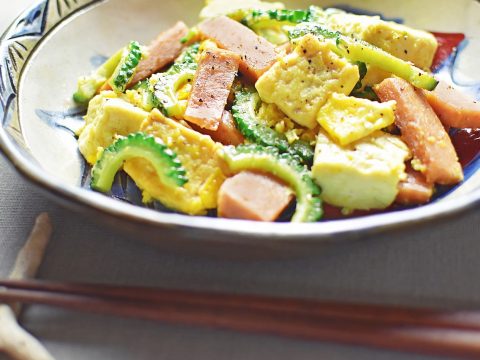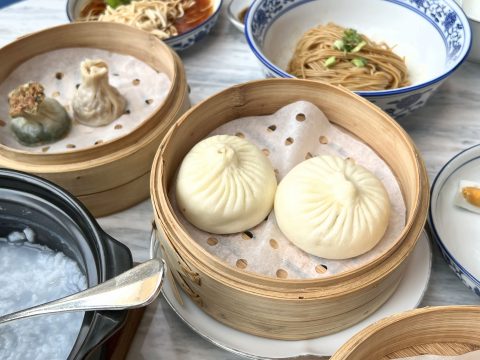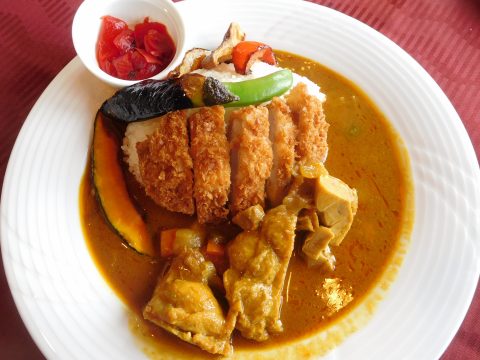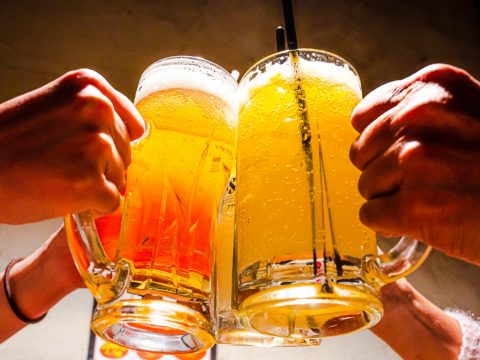Edible Cherry Blossoms: How to Make and What to Try(食用の桜)
JAPANESE FOODS
10.05.2023
I’m sure few people hear the words “cherry blossom” and don’t think of its significance in Japan. Stories of flocks of Japanese tourists migrating to their local parks every spring to sit under the bountiful cherry blossoms and enjoy picnics known as hanami (花見 “flower viewing”), or the national forecast that informs residents of when their local trees are predicted to bloom. Cherry blossoms, known as sakura (桜), are potentially one of the most culturally significant items in Japan. But Japan’s enchantment with these delicate baby-pink blooms extends far beyond a visual appreciation.

Cherry blossom tea, cherry blossom mochi, cherry blossom cookies, even cherry blossom flavoured KitKat’s: the humble cherry blossom isn’t just a pretty flower. Its versatile uses extend even to the realm of foodstuffs. Today, I will introduce you to the exciting usage of cherry blossoms and food, how Japanese chefs cure and store cherry blossoms for consumption, and what kind of cherry blossom flavoured foodstuffs are a must-try in Japan.
Types of Cherry Blossom
What many call a “cherry blossom” itself actually refers to the flower of many trees known as the genus Prunus, although the ones usually used to decorate public spaces are purely ornamental and do not bear fruit. A fun fact about cherry blossoms is that all varieties are edible. The flavour of cherry blossoms is subtle and mildly sweet. The term “sakura” only refers to around 100 species of tree and the small pink or white flowers can be easily confused with the blossoms of plum trees (which are also edible!).
In general, cherry blossoms have three varieties: single blossoms, semi-double blossoms, and double blossoms. These can be told apart by counting the petals of the flowers. The single blossoms are what we typically associate with Japanese cherry blossoms: a 5-petalled flower with a small cleft at the top creating a pointed heart shape. Semi-double blossoms tend to have 6-10 petals, and double blossoms have 10 or more.

How to Cure and Store Cherry Blossoms for Consumption
Japanese chefs use a particular method for curing cherry blossoms for consumption. The process is known as shiodzuke (塩漬け, literally “adding salt”), and involves drying out the flowers so they keep. The process is so easy, you can even try it at home!
Firstly, the cherry blossoms are harvested. This is better done just before they bloom when the blossoms are just starting to open forming a partially open bell shape. At this stage, the flowers are still young and supple. From this, the flowers are washed in cold water.
Then the flowers are placed in an air-tight container and sprinkled with salt. They are left to rest in a fridge for at least three days, periodically shaken to stop them from clumping together. After three days, enough vinegar is added to just cover the flowers and then they are left for another three days.
After this, the flowers are drained and air-dried. They are now ready to eat! These shiodzuke cherry blossoms can be used in sweet and savoury recipes to be enjoyed all year round.
To see how easy this process was, I gave it a go myself. Here are my results:


I used my flowers with some boiling water, letting them steep for around 5 minutes before drinking to make sakura-yu (桜湯 ”cheery blossom tea”). The taste is mild and fragrant, perfectly refreshing on a sunny spring afternoon!
Must-Try Cherry Blossom Foods From Japan
Cherry Blossom Mochi (桜餅)

This traditional treat is best tried when made fresh. Sakura mochi can come in many regional forms, from Kansai to Kanto, and can incorporate various other sweet treats like bean paste, chestnuts, and even cherry tree leaves!
Cherry Blossom Steamed Bread (さくら蒸しパン)

Steamed bread can be made at home or bought, but is definitely tastiest when handmade.
Cherry Blossom Additions

Shiodzuke cherry blossoms can make great decorations for other foods like lattes, cakes, and cookies. Since the flavour is so delicate and palatable, they are sure to make unoffensive additions to any food!
As seen in this article, the uses for cherry blossoms in Japan stretch beyond just a beautiful bloom; they also have many uses in food. I hope this acts as a sign for you to go out and enjoy this spring to its fullest.

Ella Clayton
Ella Clayton is a food writer, traveler, and all-around Japan enthusiast. Studying in Japan for her bachelor’s degree, she has ventured from Kansai and Kanto, and can say definitely: Osaka style Okonomiyaki is the best.
Read previous articles by the writer
Read latest articles
KEYWORDS
- # PICKPICK
- # Resume
- # alcohol
- # Rice
- # Soup
- # winter food
- # Fast Food
- # seafood
- # spicy foods
- # raw food
- # fermented food
- # Transportation
- # MEAT
- # Edo culture
- # suits
- # clothing
- # drink
- # fish
- # seasoning
- # Japanese New Years Foods
- # Toshikoshi soba
- # Osechi Ryori
- # Ozoni
- # Christmas
- # Japanese fusion pasta
- # Wafu Pasta
- # Japanese Hot Pot
- # なべ
- # 鍋
- # Miyazaki
- # Chicken Nanban
- # Karamen
- # Autumn Wagashi
- # Mushi-yokan
- # Imo-yokan
- # Japanese Autumn Fruits
- # Autumn
- # Vending Machine
- # fall
- # dango
- # Chestnut rice
- # saury
- # Mushroom
- # Rice vinegar
- # Japanese condiments
- # 調味料
- # Sake
- # Mirin
- # Soy sauce
- # Japanese Noodles
- # Udon
- # Ramen
- # Yakisoba
- # Soba
- # Japanese Seaweed
- # 海藻
- # かいそう
- # Payslip
- # Training
- # Japanese summer foods
- # 和菓子
- # Wagashi
- # ryokucha
- # 夏
- # 飲み物
- # Ramune
- # ラムネ
- # Pokari Sweat
- # ポカリスエット
- # Calpis
- # カルピス
- # Mugicha
- # ume
- # 梅
- # うめ
- # umeshu
- # job hunting
- # tofu
- # Recruitment in Japan
- # miso
- # Japanese cuisine
- # Yellowtail and bonito
- # Children’s Day
- # Kashiwa Mochi
- # Chimaki
- # fruits
- # Kusamochi
- # Types of Agriculture in Japan
- # bread
- # パン
- # パン屋さん
- # japanese bread
- # shokupan
- # meal blead
- # anko bread
- # 桜
- # さくら
- # cherry blossom
- # visa
- # hanami
- # omotenashi
- # sakura
- # おもてなし
- # Japanese hospitality
- # oshibori
- # wet hand towel
- # hand towel
- # restaurant
- # Commuting in Japan
- # Women-only cars
- # Exit gate
- # japanese train
- # train
- # valentine
- # Japanese sweets
- # 朝食
- # Japanese Breakfast
- # Breakfast
- # Japanese
- # 日本
- # healthy
- # persimmons
- # hoshigaki
- # HR
- # work in Japan
- # jinji ido
- # corporate systems
- # Japanese work culture
- # bento
- # ekiben
- # shinkansen
- # omiyage
- # train station
- # Japanese culture
- # work culture
- # mentaiko
- # umeboshi
- # Japanese snacks
- # potato chips
- # Japanese potato chips
- # Japanese writing
- # seaweed
- # konbu
- # ocean foods
- # shio konbu
- # dashi
- # miso soup
- # food processing
- # pear
- # nashi
- # sweet potato
- # japanese sweet potato
- # stingray
- # satsuma imo
- # food value chain
- # homecooking
- # agriculture
- # Japanese homecooking
- # farming
- # nikujaga
- # shojin ryori
- # meat and potatoes
- # traditional foods
- # comfort food
- # buddhist food
- # manufacturing
- # factory
- # eihire
- # vegetarian
- # food and beverage
- # izakaya
- # yatai
- # japanese festival
- # taiyaki
- # matsuri
- # summer
- # Ikayaki
- # smart agriculture
- # shaved ice
- # kakigori
- # かき氷
- # summer dessert
- # Japan
- # Japanese foods
- # dessert
- # fruit
- # matcha
- # icecream
- # Pikcup
- # Pikc up
- # Pcikup
- # skilled labor visa
- # working visa japan
- # Dineer Table in Japan
- # Japanese manner
- # Japanese food
- # Japanese Table Manner
- # Chopsticks
- # Japanese traffic signs
- # traffic information
- # road rules in Japan
- # chocolate
- # green tea
- # Osaka
- # Work Japan
- # Japanese company
- # ikura
- # sushi
- # nigiri
- # wasabi
- # PCIK
- # PICK UP
- # PICK
- # PICKUP








